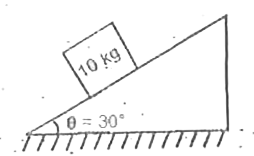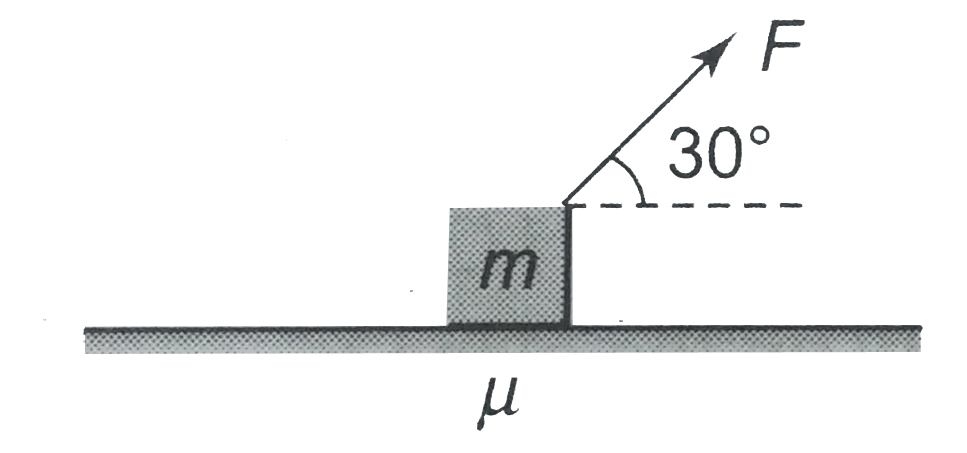A block of mass m is kept on a horizontal table. If the static friction coefficient is μ., find the frictional force acting on the block.
To solve the problem of finding the frictional force acting on a block of mass m placed on a horizontal table with a static friction coefficient μ, we can follow these steps:
1. Identify the Forces Acting on the Block:
- The block has a weight W=mg acting downwards, where g is the acceleration due to gravity.
- There is a normal force R acting upwards from the table on the block.
2. Determine the Normal Force:
- Since the block is on a horizontal table and there are no vertical forces acting on it other than its weight and the normal force, we can conclude that:
R=mg
3. Understanding Static Friction:
- The static friction force fs can vary from 0 to a maximum value given by:
fs,max=μR
- Substituting R from the previous step, we get:
fs,max=μmg
4. Condition for Friction to Act:
- Static friction only acts when there is an external force trying to move the block. If no external force is applied, the static friction force will be 0.
- Therefore, if there is no applied force F on the block, the frictional force acting on it is:
fs=0
5. Conclusion:
- The frictional force acting on the block is 0 when no external force is applied.
Final Answer:
The frictional force acting on the block is 0.
---
- The block has a weight W=mg acting downwards, where g is the acceleration due to gravity.
- There is a normal force R acting upwards from the table on the block.
- Since the block is on a horizontal table and there are no vertical forces acting on it other than its weight and the normal force, we can conclude that:
R=mg
- The static friction force fs can vary from 0 to a maximum value given by:
fs,max=μR
- Substituting R from the previous step, we get:
fs,max=μmg
- Static friction only acts when there is an external force trying to move the block. If no external force is applied, the static friction force will be 0.
- Therefore, if there is no applied force F on the block, the frictional force acting on it is:
fs=0
- The frictional force acting on the block is 0 when no external force is applied.
The frictional force acting on the block is 0.
Topper's Solved these Questions
Similar Questions
A block of mass m is kept on horizontal turn table at x distance from the centre. If coefficient of friction between block and surface of turn table is μ, then maximum angular speed of the table so that block does not slip

View SolutionA block of mass M is kept on as rough horizontal surface. The coefficient of static frictionbetween the block and the surface is μ. The block is to be pulled by applying a force to it. What minimum force is needed to slide the block? In which direction should this force act?
View Solution
Knowledge Check
A lift is moving downwards with an acceleration equal to g. A block of mass m , kept on the floor of the lift of friction coefficient μ , is pulled horizontally . The friction acting on the block is
AμmgBmgCzeroDNoneA block of mass m=1/3 kg is kept on a rough horizontal plane. Friction coefficient is μ=0.75. The work done by minimum force required to drag to the block along the plane by a distance 5m is :-
A8 JB4 JC2 JD6 JA block of mass 4 kg is kept on a rough horizontal surface. The coefficient of static friction is 0.8. If a force of 19 N is applied on the block parallel to the floor, then the force of friction between the block and floor is
A32 NB18 NC19 ND9.8 N
A block of mass m rests on a horizontal floor for which coefficient of friction is μ . Find the magnitude and the direction of force that should be applied to just move the block so that the applied force is minimum.
View SolutionA block of mass 10 kg is kept on a fixed rough (μ=0.8) inclined plane of angle of inclination 30∘. The frictional force acting on the block is

View SolutionA block of mass 1kg is at rest on a horizontal table. The coefficient of static friction between the block and the table is 0.5 . The magnitude of the force acting upward at an angle of 60∘ from the horizontal that will just start the block moving is.
View SolutionA block of mass 20 kg is pushed with a horizontal force of 90N. If the coefficient of static and kinetic friction are 0.4 and 0.3, the frictional force acting on the block is (g=10ms−2)
View SolutionA block of mass m lying on a rough horizontal surface of friction coefficient μ is pulled by a force F as shown , the limiting friction between the block and surface will be

View Solution
